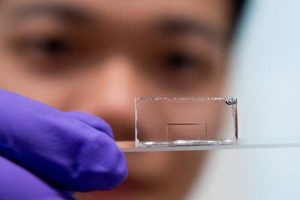
“Our technique uses the interaction of photons and acoustic waves to enable an increase in signal capacity and therefore speed,” said Dr Elias Giacoumidis of the University of Sidney. “This allows for the successful extraction and regeneration of the signal for electronic processing at very-high speed.”
The incoming photonic signal is processed in a filter on a chip made from chalcogenide glass using stimulated Brillouin scattering (SBS).
The technique, that has been demonstrated at over 116Gbit/s, is a form of self-coherent optical orthogonal frequency-division multiplexing (self-CO-OFDM), which typically needs a wide guard band to allow the carrier to be extracted at the receiver, disregarding close-in OFDM sub-carriers, according to the paper ‘Chip-based Brillouin processing for carrier recovery in self-coherent optical communications‘ in Optica which describes the work. This leaves only local oscillator-based techniques if a lot of sub-carriers are needed.
However, “our demonstration device using stimulated Brillouin scattering has produced a record-breaking narrowband of about 265MHz for carrier signal extraction and regeneration”, said researcher Dr Amol Choudhary (pictured left). “This narrow bandwidth increases the overall spectral efficiency and therefore overall capacity of the system.”
The team is claiming a comparable performance to state-of-the-art coherent optical receivers, better phase and polarisation stability than fibre-based SBS techniques, less load on subsequent digital processing stages, and lower latency.
“The fact that this system is lower in complexity and includes extraction speed-up means it has huge potential benefit in a wide range of local and access systems such as metropolitan 5G networks, financial trading, cloud computing and the Internet-of-Things,” claimed group research leader Professor Ben Eggleton (right in photo).
Use relax the requirements on very-high-order modulation signalling for future communication networks is proposed, as well as in long-baseline interferometry for precision optical timing, or reconstructing a reference tone for quantum-state measurements.
The study was a collaboration with Monash University and the Australian National University.
 Electronics Weekly Electronics Design & Components Tech News
Electronics Weekly Electronics Design & Components Tech News



